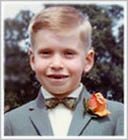An Illustrated History of Old Sutton in St Helens, Lancashire
Part 60 (of 95 parts) - Memories of Sutton Part 10
Compiled by Stephen Wainwright ©MMXX
'School Memories from the 1940s & '50s' by Harry Hickson
I started infant school at Marshalls Cross at the age of four, and there were two teachers at that time. Mrs Finch who lived at Eccleston Park, was the Headmistress, and had in fact taught my brother ten years previously. The other teacher was a Miss Lamb, who lived in Mill Lane, just past the Mill House Hotel car park. Marshalls Cross was a good school with both teachers very friendly and interested in children. It was a simple open plan building with a pitched roof. Upon entering from Mill Lane, you went straight into the narrow, side cloakroom annex, which had a small kitchen at one end.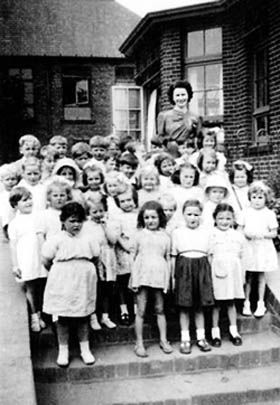
Going to Robins Lane Primary school was certainly a step into the big league after this, but as Janet Watson (née Whitfield) has said in her article in Memories of Sutton 8, it was a good school too. It was good to see Janet's contribution as I remember her well, always a lovely smile. The school was built down a slope which gave it a second floor at the bottom end, all the classrooms being light and airy and all looking out onto the sports field on the Robins Lane side. It certainly had the latest in modern school features, and the Headmaster Mr Frank Briggs, played his part in making it a good school. In Janet's class 2A photo, I had hoped she would have supplied some names but I've added them and hopefully Janet (or others), can fill in the gaps.
In spite of being a big school, it could not accommodate all the students it needed to, and about 45 of the final year were sent to Sutton Road, where classrooms were set up in a hall at the rear of the old Methodist Chapel. It really was a step back in terms of facilities, but I suppose they felt the least impact would be on the final year students.
There were two teachers at Sutton Road at that time, Mrs Courtman, who was married to Ken Courtman, the well known bespoke tailor in Westfield Street, opposite Beechams, who occasionally picked her up in his Red MG, and a Mr Shaw, who was a lovely guy. Mrs Courtman was very stern and wouldn't hesitate to apply physical punishment to anybody who upset her. She could however, even by the strict standards of the day, be considered to be an 'unfair cruel' teacher subjecting her pupils to outbursts of violent temper.
Two examples vividly illustrate this, which were traumatic not only for the children involved, but also for the rest of the class who were witnessing her outbursts. Her method in both cases was the same, namely grabbing the student by the hair and pushing their face into the blackboard two to three times, while screaming at them. In the first example she did this to a girl named Barbara Lees who lived in Clovelly Avenue, a lovely quiet girl with long black hair in ringlets, and who had sadly lost her mother when she was about 3 years old (her mother only being 29 at the time). Barbara in no way could be considered a disruptive student, but that really didn't matter with Mrs Courtman. She only had to see you whispering to somebody for her to get wound up, and seeing this happen to Barbara was really terrifying for the class. In fact it had such an impact on Janet Whitfield that even later that day, her mother could not console her.
Reggie Holmes was the other student to receive this treatment some weeks later. Reg lived at the corner of Baxters Lane and Robins Lane, and again was a quiet, reserved lad. He didn't have too many close friends, a characteristic, I think, which was developed by his own interests through a difficult home life. After Mrs Courtman pushed his face into the blackboard he ran crying out of the classroom and the school itself, ignoring her calls to come back and sit down. I think on this occasion Mrs Courtman was frightened that Reg may report her and she asked me to go and find him and bring him back. This was based, I think, on her knowing that Reg and I did communicate a bit, and to be honest, I was glad to get out of the classroom anyway. Not a lot of the class knew that Reg had a 'secret den' which he had once showed myself and Les Grace. It was in a series of tunnels under the long demolished Glass Plate Factory that was between Baxters Lane and Lancots Lane, and actually situated not too far from Reg's home.
I suspected that he had gone there, and after crawling in the dark for about 50 yards, round twists and turns, found him there in his den. Inside he had set up a makeshift table, a seat with sacking on it, a couple of books, old comics, knick knacks etc and a candle in a jam jar. He was still crying after his ordeal, and I asked him to come back, telling him a little white lie that she was sorry, that she hadn't meant to do it and whilst I think he thought this was a load of rubbish, he eventually agreed to come back. On entering the classroom, all that Mrs Courtman said was that he shouldn't do that again, to sit down and be quiet.
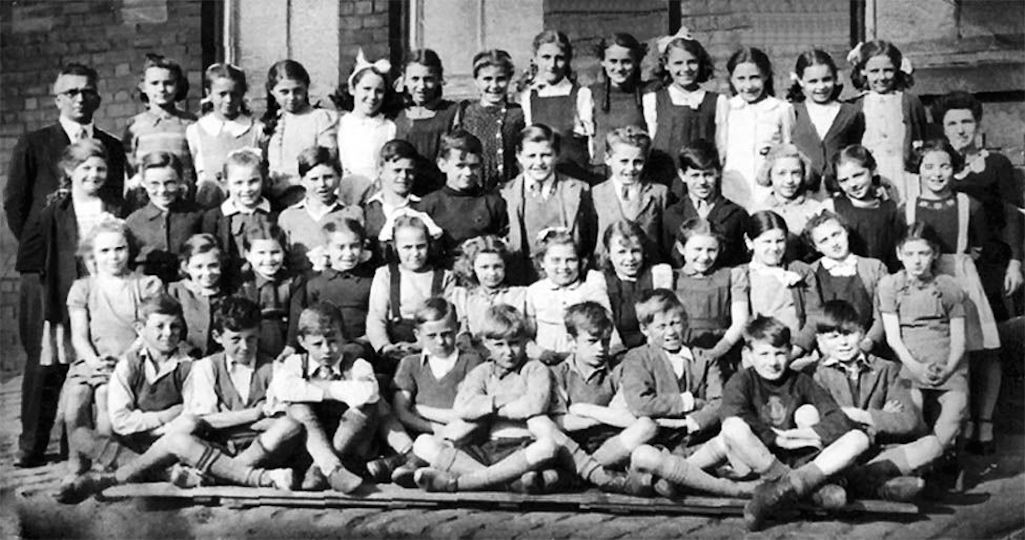
Class photo at Sutton Road school - the pupils were transferred from Robins Lane - contributed by Harry Hickson

Class photo at Sutton Road school - the pupils were transferred from Robins Lane

Class photo at Sutton Road school
Deep down he was an intelligent lad who needed a good teacher to develop his obvious talent. Today we could have all had sessions with a child psychologist to cope with the trauma, and for Janet, her faith in teachers was later restored by Mrs Ashton, a case of chalk and cheese no doubt! It gives me no pleasure to relate this part of my Memories, because it was, as I said, very traumatic at the time. It did however happen, and I am somewhat comforted in publishing this by the fact that Mrs Courtman has now passed on, and did so without leaving any children.
Above is a class photo from that period at Sutton Road, which basically has the majority of students on the Robins Lane photo within Janet's article. L to R Back Row: Mr Frank Briggs (Headmaster), Rita Greenall, ?, ?, ?, ?, Norma Harrison, Pauline Bridge, Lily Twist, ?, Barbara Rigby, ?, Barbara Lacy, Mrs Courtman. L to R 2nd Back Row: ?, Anne Thomas, ?, ?, ?, Alan Mercer, Keith Rimmer, Myself, Gordon Toman, Joan Simms, Barbara Watkinson, Sheila Pennington. L to R 2nd Front Row: Margaret Astell, Jean Johnson, Dorothy Woolerston, ? Rearden, Glenda Sheppard, Barbara Fairhurst, Betty Hawley, Janet Whitfield, Ellen? Finney, Joan Chesworth, Barbara Lees, Julia Flavell. L to R Front Row: Keith Newton, Albert Molyneux, Derek Smith, Roy Thomas, Les Grace, Lem' Gallyer, Harry Thomas, Reg Holmes, ?. My apologies to those I can't remember or who I have mistakenly identified.
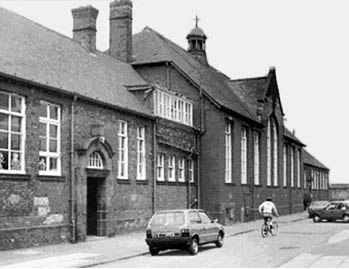
This photograph on the right (above for mobile users) contributed by Kathleen Fehrman, shows the nearest entrance to the boys school, with Mr Bowles classroom (Technical Drawing etc) being on its left. The cloakroom / washrooms are to its right, with the teachers' staff room being housed in the upstairs dormer section above. This is followed in the middle by the 'Joint Schools', Gym / Stage / Assembly Hall.
I think there were six classrooms in the main building, plus a library that was used as one, and the woodwork classroom at the top (Marshall's Cross Road end). The respective outside break areas were between the classrooms and the canteen. It was found that again there were insufficient rooms for all the students wanting to attend, which I suppose was a sign of all the people moving into the district. Alongside the girls' wing (Cottage Hospital / Clayhole side), a number of temporary-type buildings had been erected, including a Metal Workshop and a Science Lab.
We also had a garden plot, which was on the other side of Marshalls Cross Road, a little down from Robins Lane and next door to Lester's Garage. The sports field at the front of the building was really too small, had quite a slope to it, and because of this it had become devoid of grass and was hard and uneven. Sports were held in Sutton Park, plus part of Sherdley Park, and cross country through Sherdley Score, starting in Marshalls Cross Road and up Eltonhead Road. A number of the teachers had been in the war in difficult theatres of conflict. Mr Davies (ex Grange Park) and Mr Tunstall had been on destroyers in convoys and Mr Llewellyn was at Anzio. We had a new Headmaster in Mr. E.R. Rogers who was a well qualified, new breed head who was keen on changing the culture, and wore the standard gown for assembly, striding in as everybody stood up.
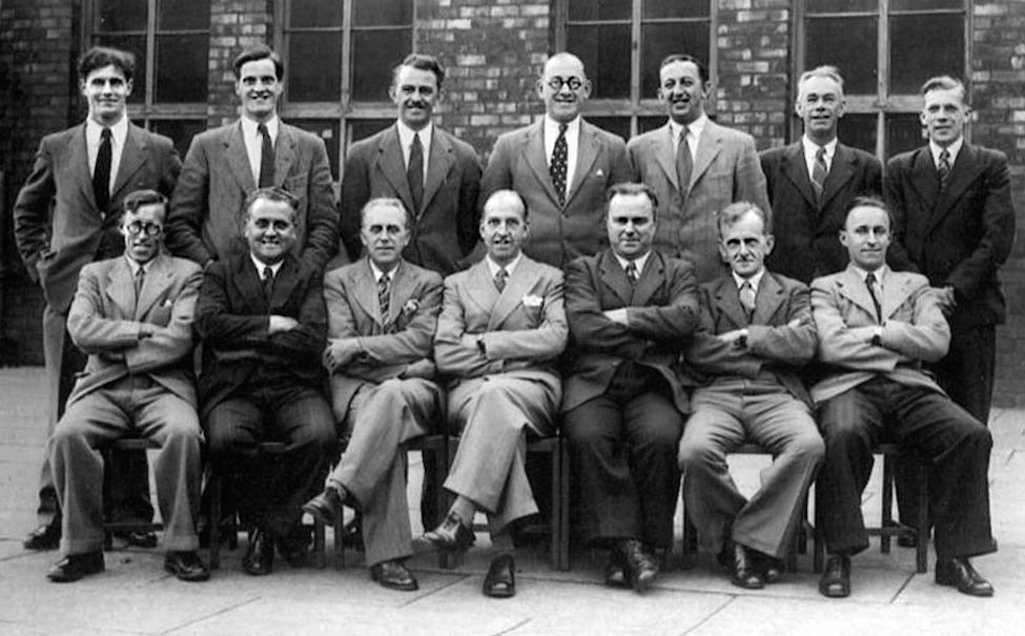
The staff at Robins Lane Secondary Boys School in Sutton c.1950 - contributed by Harry Hickson

Robins Lane Secondary Boys School Staff c.1950

Robins Lane Boys Staff c.1950
Mr Llewellyn was Saint's latest signing in 1948, and my form master. I can see him now sat at his desk on the first day waiting for us to come in. Other lads in different classes or schools would ask us what he was like and could we get his autograph. Although he moved onto Grange Park school and later suffered with Parkinsons Disease, he remembered much of his time at Robins Lane, quoting names when I met him again a few years before he died, he was a lovely man.
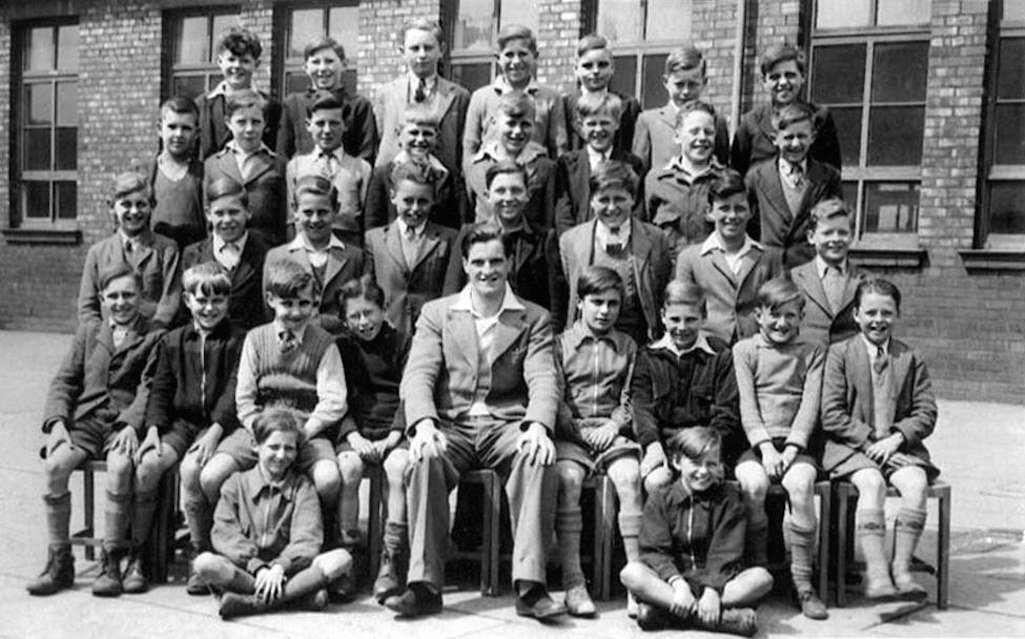
Robins Lane boys form photograph from 1948 with Saints star Stewart 'Steve' Llewellyn - contributed by Harry Hickson

Robins Lane boys form photo from 1948 with Saints star Stewart 'Steve' Llewellyn

Robins Lane boys from 1948 with Saints star Stewart ‘Steve’ Llewellyn
Mr Fred Thomas, the Woodwork teacher, was a large man and he had a big model of the Liner Olympic on display in a glass case. This was the sister ship to the Titanic, and we thought it was fantastic. Mr. Thomas lived in New Street with his wife Beryl and son Malcolm. He came up to me one day in class and said "Mrs Thomas and I would like Malcolm to join the choir, and if successful in doing that, we would like you to mentor and look after him. Do you understand me Harry?". "Yes I do Mr Thomas", I replied. " I was sure you would Harry".
In the woodwork class after that, after Malcolm had joined the choir, I got special attention from Mr Thomas. When it came to the end of year project, for which I had decided to make a sewing box on legs with a hinged lid, Mr. Thomas said to me: '' Harry, Mrs Thomas and I are very pleased with how you have looked after Malcolm, and in appreciation I am going to give you a piece of 'choice oak' for your box''. I am also pretty sure I finished the year with the top marks and, of course, a glowing comment added in the school report. It was my first introduction to bribery and corruption!" He certainly didn't stand any nonsense from students, but generally all the teachers were their own characters and very good
I wonder how many ex-students can remember Mr (or Daddy as we called him) Owens' own particular characteristic when he was teaching maths? He would stand in the front of the class and keep repeating (about five times), a principle or formula. He emphasised it with an open outstretched palm in which he could put two fingers together on either side, forming a perfect V (I still cannot do it). Mr Rogers created a school council made up of some students, and you had to go through a formal interview to get on it. This related mainly (his pet theme) as to how you helped people in your life eg. doing little jobs for an elderly neighbour.
I tell the following story for a reason, as interestingly it involves Janet Watson's brother Russell, who was a bit older than us. One day there was a scuffle in the yard between Russell and I think Derek Twist from Leach Lane, and they agreed to settle their differences in Sutton Park after school. This took place with a crowd of lads including me watching and it didn't last all that long. The next morning I was told to report to the Headmaster's office where Mr Rogers was sat in his gown, and he proceeded to ask me if there had been a fight and had I watched it.
The answer, of course, was yes, which prompted him to jump up, open a cupboard and take out a long cane. He flexed it and then gave me six strokes, during which I had to ensure that I didn't wince or show any emotion. My crime was going along with a public display unbecoming of the high school standards, and the principles of the student council in particular. Being a member, I should have stopped it. All in all though, I did enjoy my school days at the Secondary School and I hope everybody remembers it with affection.
'My St.Nicholas Choir Days' by Harry Hickson
The history of St Nicholas Church would not be complete without a look at a period in which it had a great choir. A biased opinion I admit, as I was a chorister there for about five years. However, I think that most of its parishioners at the time would agree with me. This period was in the mid-1940s to early '50s, when the choir had both strong 'Men' and 'Boys' sections, covering the whole range of voices. Most of the young chorister voices 'broke' at 14 or 15 years of age, but there was still a plentiful supply of lads waiting to get a place. In fact you could turn up on, say, a Sunday evening, and no positions would be available.One of these lads was then chosen to pump the organ, a job that consisted of pushing up and down a long horizontal wooden lever which operated a pair of bellows that supplied air to the organ pipes. It had a small weight on a string line which went up as the air was used, and down as you pumped with a line drawn behind, beyond which the weight should not rise past. If you were distracted and didn't watch the warning feature, the organ could be starved of air with no sound coming out at all, which was very embarrassing.
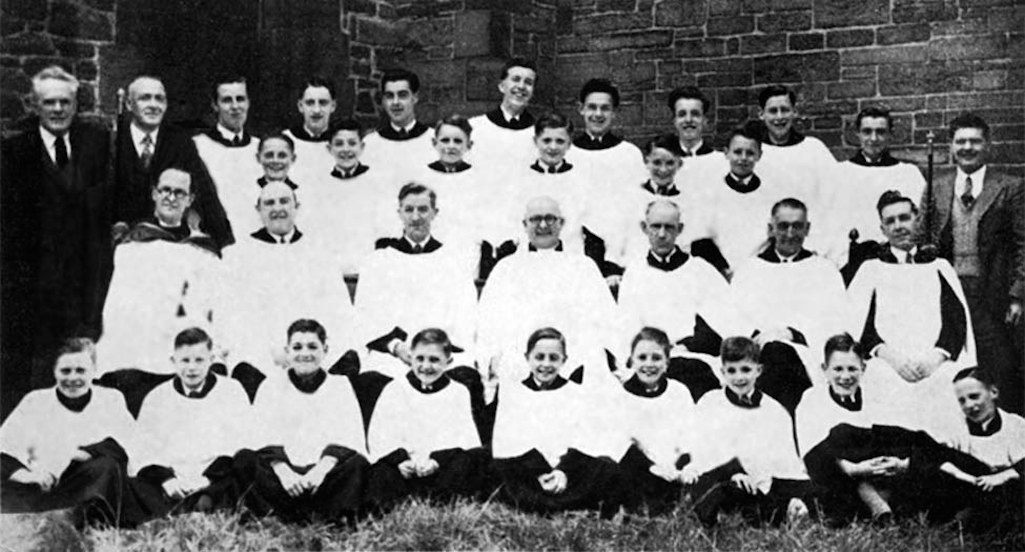
St.Nicholas Choir in 1949 taken to celebrate the centenary of the church - contributed by Harry Hickson

St.Nicholas Choir in 1949 taken to celebrate the centenary of the church

St.Nicholas Choir pictured in 1949
The quality of the choir was also due to the tremendous contribution made by the organist Frank Alcock. He was a remarkably dedicated man who travelled from his home at Moss Bank in all weathers (fog, rain, snow etc) on his autocycle. He never missed coming to the church, which meant twice on Sundays, choir practice on Tuesdays (I think) and also weddings on Saturdays when required. When we turned up for practice he would already have arrived and would be busy practicing on the organ, making a lovely sound in the empty church. What was even more remarkable was the fact that he had some physical difficulties, namely a half-amputation of two of his fingers on his left hand. He also had a pronounced built-up boot on his right foot and he walked with a limp as a result. In spite of this he was a good organist, who long after I had left the choir, went to play at Ravenhead St Johns church, where I met him on a return visit to the town.
The men had some great voices in their ranks, which made a major contribution to the enjoyment of the parishioners with church services nearly always being full. Amongst them was Mr. Rowley from Leach Lane, who was a winder at Clock Face Colliery and had a lovely voice. The Vicar during most of my time in the choir was the Rev. Jones, an elderly Welshman who lived at the Vicarage in New Street and whose daughter - as Janet Watson mentioned in Memories of Sutton 8 - taught at Robins Lane Junior School.
The Vicar's sermons were of the 'old school' type, a bit formal and to us choirboys somewhat boring. As he climbed the pulpit steps and started his sermon, the lights in the choir stalls would be turned down, and we could settle back. However, we found it difficult to sit still and stay quiet, and whispering would soon start. In the choir was a man named James Bath, or Jimmy Bath, as we knew him. He lived with his sister Lucy at her shop at the very top of Mill Lane, opposite Marshalls Cross school. He was a stickler for correct behaviour and would think nothing of walking across to the choir stalls on the opposite side to chastise a boy who was talking.
If you were sat on his side in front of him, he would push his hymn book forward on its rest, hitting you on the back of the head. He was able to reach about four boys with this technique! Jimmy was, however, very generous to us and on our Annual Choir trip to Southport, he would give every boy a shilling to spend, and you could get a few rides on the fair with that. The trip was always the same, a sit down meal at the Star Cafe with fish and chips, bread & butter, cup of tea, lemonade or dandelion and burdock, all very enjoyable for everybody.
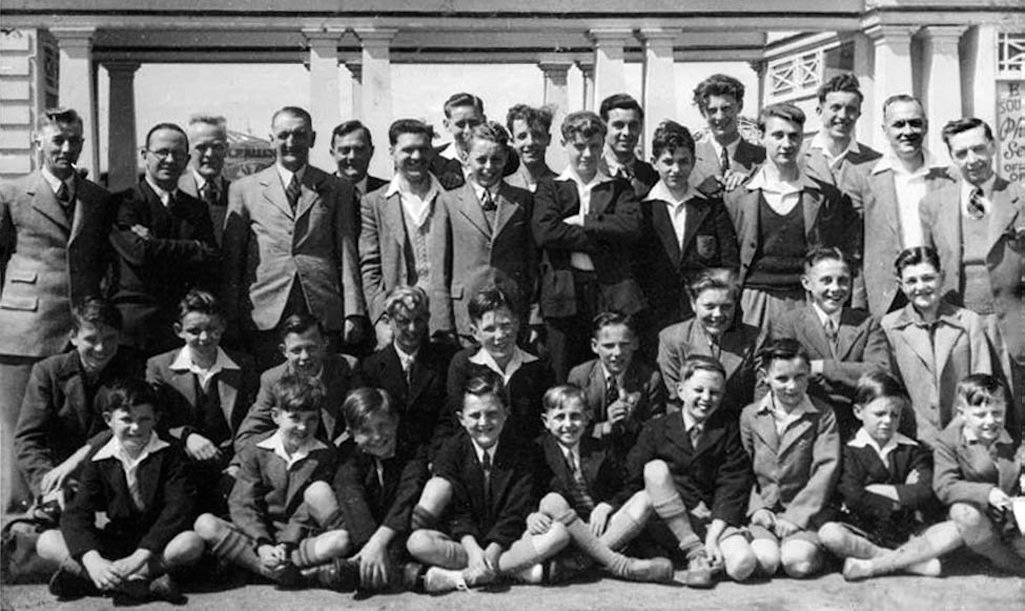
St.Nicholas Choir trip to Southport in June 1950 - contributed by Harry Hickson

St.Nicholas Choir trip to Southport in June 1950

St.Nicholas Choir trip to Southport
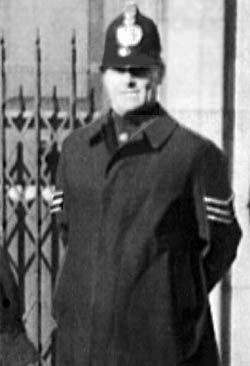
I cannot finish this article without relating a story that depicts life in those days with regard to behaviour by children, and the discipline that was common place. One November evening we were on our way to choir practice with another couple of boys who lived in the same avenue. We walked up New Street alongside Farmer Heyes’s field in which he was growing turnips. One boy leaned over and picked a turnip out of the ground. He swung it round so it went into the air, then tipped it over and it came down like a parachute. After being smashed on the road, we were able to eat pieces of it.
This was vandalism, I know, but it was just a bit of fun or so we thought. Into church we went, and we were singing away for about twenty minutes when there came a knock on the Vestry door. Mr Alcock went to answer it and he came back in saying it was my father for me. My father was a very strict policeman, and when I went to the door he was standing with Farmer Heyes, who he knew very well. We had been seen and reported, so my father asked me if I had been in the field and one thing you could not do was to tell a lie. If you did and were found out, it was twice as bad.
He then took off his police belt, and 'tanned' my backside with it, until Farmer Heyes said it was enough. My father promptly walked into church and addressed the choristers, telling them what he had done and why. He knew I wasn't on my own, so a couple of other lads could expect the same when they got home. He then apologised to Mr Alcock for interrupting the practice, and left us to carry on, with everybody grinning at me. Today of course, he and all the other fathers couldn't do that without being prosecuted. But provided it was done properly, I certainly didn't hold it against him.
Those choir days were very happy ones and it was a bit sad many years later on a visit to Sunday Morning Service that I saw there were no boys in the choir.
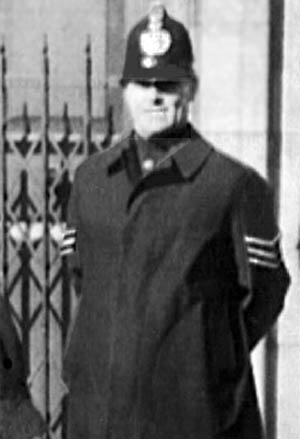
Sergeant Alf Hickson c.1944
